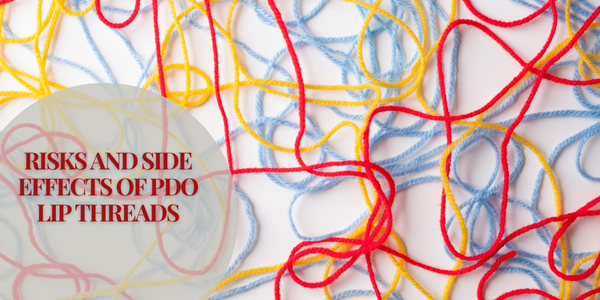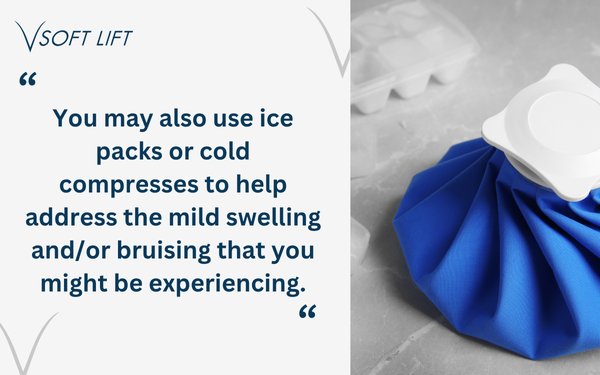
PDO lip threads are considered one of the top cosmetic treatments for people who are showing signs of aging in their lip and mouth area. The minimally-invasive procedure can produce amazing results, addressing sagging and drooping skin, lack of contour and shape, thin lips, fine lines and wrinkles and much more.
These treatments are valued for their accessibility, affordability, quick procedure time, and lack of downtime/recovery time. People also love PDO lip thread treatments because they can repeat the procedure at any time to achieve the results they’re looking for.
If you’ve never had a PDO lip thread procedure before, you might be wondering what the possible risks and side effects are. We’ll discuss that below, including why the risks are so low.
PDO threads are made from a synthetic material called polydioxanone that is 100% biodegradable and biocompatible. In layman’s terms, this means that the body uses natural processes to break down and dissolve the threads, and that there is very low risk of significant complications.
 Medically reviewed by: Elizabeth Williams RN
Medically reviewed by: Elizabeth Williams RN
Updated: 6/4/2025
PDO threads are made from a synthetic material called polydioxanone that is 100% biodegradable and biocompatible. In layman’s terms, this means that the body uses natural processes to break down and dissolve the threads, and that there is very low risk of significant complications.
PDO threads have actually been used for many years now as dissolvable surgical sutures, so the proof is in the pudding, as the saying goes, when it comes to use cases.
PDO threads do not have to be removed, as the body will simply work to break them down over time. To do so, it will produce extra collagen in the treatment area, which also has the side benefit of extending the results of the procedure, while causing your skin to have greater laxity, plumpness and an overall more youthful look.
| Risk/Side Effect | Severity | Likelihood | Prevention/Tips |
|---|---|---|---|
| Infection | Moderate | Rare | Choose a qualified provider; sterile techniques |
| Asymmetry | Mild–Moderate | Rare | Proper thread placement; follow aftercare |
| Thread Extrusion | Mild | Rare | Use quality threads; avoid facial pressure |
| Bruising/Swelling | Mild | Common | Use cold compresses; avoid NSAIDs |
| Nerve Damage | Severe | Extremely Rare | Qualified provider only |
Before the treatment begins, your provider will use local anesthetics to ensure you are sufficiently comfortable. As the provider is inserting the PDO lip threads into your skin, you may feel some slight tugging or pressure, but you shouldn’t feel any pain.
Following the treatment, most people experience mild swelling and/or bruising. In most cases, this will resolve itself in about a week or less.
You can ensure that your body heals properly by following your provider’s post-care instructions, including avoiding strenuous activities, deep facial massages or cleansing, and taking certain medications such as NSAIDs and aspirin.
You may also use ice packs or cold compresses to help address the mild swelling and/or bruising that you might be experiencing.

While rare, there are some other possible risks and side effects of PDO lip threads.
The first is infection, which is a potential concern any time that something is being inserted into your body. Since your provider will need to put puncture sites in your face, there is a chance of infection, though this should be quite rare.
It’s also possible to experience asymmetry in your face. If this were to occur, it’s likely because your provider didn’t place the threads properly, or you did something in the post-care phase that caused the threads to move out of position.
In the same vein, thread extrusion is a potential side effect. When this happens, the PDO threads will actually protrude out of your skin and become visible.
A final potential risk is nerve damage. Just like infection, though, this is extremely rare and would likely only occur if your provider inserted the PDO lip threads incorrectly and hit a nerve while doing so.
There are a few things that you can do to minimize the risks and side effects of PDO lip threads.
First, it’s very important to choose a provider who is trustworthy and has experience with PDO thread treatments. As you can see from above, some of the possible risks have to do with how the threads are handled and inserted. So, by choosing a good provider, you can minimize some of those risks.

Second, make sure to follow your provider’s post-care instructions. Doing so will promote healing and reduce some of the risks as well.
Finally, ensure that your provider uses high-quality PDO threads, such as the ones we produce at V Soft Lift. By choosing the best product on the market, you will be reducing the likelihood of the threads themselves causing issues once they’re inserted into your face.
For more information, contact us today.
Please be aware that you are about to access the international website for V Soft Lift PDO Threads. It’s essential to note that this site has not undergone evaluation by the USA FDA.
The information provided on this platform may discuss regulatory clearances in countries outside the United States. Consequently, it might include indications and uses that extend beyond the FDA-cleared labeling for the product.
It’s important to emphasize that the details presented on this website are not intended to diagnose, treat, cure, or prevent any disease. This information should not be seen as a replacement for advice from a qualified physician or healthcare professional.
I Agree :
I Disagree :